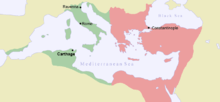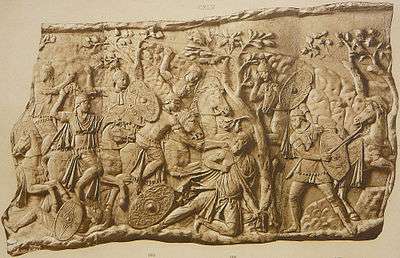Jordanes
Jordanes (/dʒɔːrˈdeɪniːz/), also written as Jordanis or Jornandes,[1] was a Gothic 6th-century Eastern Roman bureaucrat[2] who became a historian later in life. Jordanes wrote Romana, about the history of Rome, but his best-known work is his Getica, which was written in Constantinople[3] about 551 AD.[4] Along with Isidore of Seville's Historia Gothorum, it is one of only two extant ancient works dealing with the early history of the Goths.

Jordanes was asked by a friend to write Getica as a summary of a multi-volume history of the Goths by the statesman Cassiodorus that existed then but has since been lost. Jordanes was selected for his known interest in history and because of his own Gothic background. He had been a high-level notarius, or secretary, of a small client state on the Roman frontier in Scythia Minor, modern southeastern Romania and northeastern Bulgaria.[5]
Other writers, such as Procopius, wrote works that are extant on the later history of the Goths. Getica has been the object of much critical review. Jordanes wrote in Late Latin rather than the classical Ciceronian Latin. According to his own introduction, he had only three days to review what Cassiodorus had written, meaning that he must also have relied on his own knowledge.
Life
Jordanes writes about himself almost in passing:[6][7]
The Sciri, moreover, and the Sadagarii and certain of the Alani with their leader, Candac by name, received Scythia Minor and Lower Moesia. Paria, the father of my father Alanoviiamuth (that is to say, my grandfather), was secretary to this Candac as long as he lived. To his sister's son Gunthigis, also called Baza, the Master of the Soldiery, who was the son of Andag the son of Andela, who was descended from the stock of the Amali, I also, Jordanes, although an unlearned man before my conversion, was secretary.
Paria was Jordanes's paternal grandfather. Jordanes writes that he was secretary to Candac, dux Alanorum, an otherwise unknown leader of the Alans.
Jordanes was notarius, or secretary to Gunthigis Baza, a nephew of Candac and a magister militum of the leading Ostrogoth clan of the Amali.
This was ante conversionem meam ("before my conversion"). The nature and details of the conversion remain obscure. The Goths had been converted with the assistance of Ulfilas (a Goth), made bishop on that account. However, the Goths had adopted Arianism. Jordanes' conversion may have been a conversion to the trinitarian Nicene creed, which may be expressed in anti-Arianism in certain passages in Getica.[8] In the letter to Vigilius he mentions that he was awakened vestris interrogationibus - "by your questioning".
Alternatively, Jordanes' conversio may mean that he had become a monk, or a religiosus, or a member of the clergy. Some manuscripts say that he was a bishop, some even say bishop of Ravenna, but the name Jordanes is not known in the lists of bishops of Ravenna.
Works

Jordanes wrote his Romana at the behest of a certain Vigilius. Although some scholars have identified this person with Pope Vigilius, there is nothing else to support the identification besides the name. The form of address that Jordanes uses and his admonition that Vigilius "turn to God" would seem to rule out this identification.[9][10]
In the preface to his Getica, Jordanes writes that he is interrupting his work on the Romana at the behest of a brother Castalius, who apparently knew that Jordanes possessed the twelve volumes of the History of the Goths by Cassiodorus. Castalius wanted a short book about the subject, and Jordanes obliged with an excerpt based on memory, possibly supplemented with other material to which he had access. The Getica sets off with a geography/ethnography of the North, especially of Scandza (16–24). He lets the history of the Goths commence with the emigration of Berig with three ships from Scandza to Gothiscandza (25, 94), in a distant past. In the pen of Jordanes, Herodotus's Getian demigod Zalmoxis becomes a king of the Goths (39). Jordanes tells how the Goths sacked "Troy and Ilium" just after they had recovered somewhat from the war with Agamemnon (108). They are also said to have encountered the Egyptian pharaoh Vesosis (47). The less fictional part of Jordanes's work begins when the Goths encounter Roman military forces in the third century AD. The work concludes with the defeat of the Goths by the Byzantine general Belisarius. Jordanes concludes the work by stating that he writes to honour those who were victorious over the Goths after a history spanning 2,030 years.
Controversy
Several Romanian and American historians wrote about Jordanes's error when considering that Getae were Goths. According to this interpretation, much of the historical data about Dacians and Getae were wrongly attributed to Goths.[11][12][13][14]
Arne Søby Christensen and M. Kulikowski[15][16] argue in their works that Jordanes developed in Getica the history of Getic and Dacian peoples mixed with a lot of fantastic deeds. Caracalla (in 214) received "Geticus Maximus" and "Quasi Gothicus" titles following battles with Getae and Goths.
See also
Notes
- According to Schanz-Hosius (Geschichte der Römischen Literatur, 4, vol. 2 (1920), pp. 115, 118) the best MSS of his work present his name as Jordanes, as does the 'Geographus Ravennas'. Jordanis is a 'vulgar' form that is also used, while Jornandes only appears in lesser MSS. The form Jornandes, however, was often used in older publications.
- "If Jordanes was a bishop (as is frequently assumed) and if he lived in Italy (also frequently assumed), those elements of his background have left no trace in his two histories" (Brian Croke (1987), "Cassiodorus and the Getica of Jordanes", Classical Philology, 82: 119 (117–134)., doi:10.1086/367034
- "Constantinople is "our city" (Getica 38).
- He mentions the great plague of 542 as having occurred "nine years ago" (Getica 104). Still, there are some modern scholars who opt for a later date, see Peter Heather, Goths and Romans 332-489, Oxford 1991, pp. 47-49 (year 552), Walter Goffart, The Narrators of Barbarian History, Princeton 1988, p. 98 (year 554).
- Croke 1987.
- Jordanes, Mierow (ed.), Getica 266
- Jordanes, De origine actibusque Getarum L, archived from the original on 2008-02-13, retrieved 2007-08-17
- Getica 132, 133, 138, noted by Croke 1987:125
- Arne Søby Christensen (2002), Cassiodorus, Jordanes, and the History of the Goths. Studies in a Migration Myth, ISBN 978-87-7289-710-3, archived from the original on 2007-08-21, retrieved 2007-08-15
- James J. O'Donnell (1982), "The Aims of Jordanes", Historia, 31: 223–240, archived from the original on November 9, 2007
- Walter Goffart, The Narrators of Barbarian History, Princeton 1988, p. 70.
- Pârvan, Vasile (1928). Dacia: An Outline of the Early Civilization of the Carpatho-Danubian Countries. The University Press
- Oțetea, Andrei (1970). The History of the Romanian people. Scientific Pub. Hoose.
- Ioan Bolovan, Florin Constantiniu, Paul E. Michelson, Ioan Aurel Pop, Christian Popa, Marcel Popa, Kurt Treptow, A History of Romania, Intl Specialized Book Service Inc. 1997
- Arne Søby Christensen (2002), Cassiodorus, Jordanes, and the History of the Goths. Studies in a Migration Myth
- M. Kulikowski, Rome’s Gothic Wars, p. 130,
References
- Mierow, Charles Christopher, The Gothic History of Jordanes: In English with an Introduction and a Commentary, 1915. Reprinted 2006. Evolution Publishing, ISBN 978-1-889758-77-0.
- Kulikowski, Michael, Rome's Gothic Wars, p. 130.
- Arne Søby Christensen, Cassiodorus, Jordanes, and the History of the Goths. Studies in a Migration Myth, 2002, ISBN 978-87-7289-710-3
- Kai Brodersen, Könige im Karpatenbogen: Zur historischen Bedeutung von Jordanes' Herrscherliste. In: Zeitschrift für Siebenbürgische Landeskunde 36 (2013) pp. 129–146 (ISSN 0344-3418)
External links
- Works by Jordanes at Project Gutenberg
- Works by or about Jordanes at Internet Archive
- Jordanes, The Origins and Deeds of the Goths, translated by Charles C. Mierow. alternative.
- James J. O'Donell (1982), "The Aims of Jordanes", Historia, 31: 223–240, archived from the original on November 9, 2007
- The Origins and Deeds of the Goths
